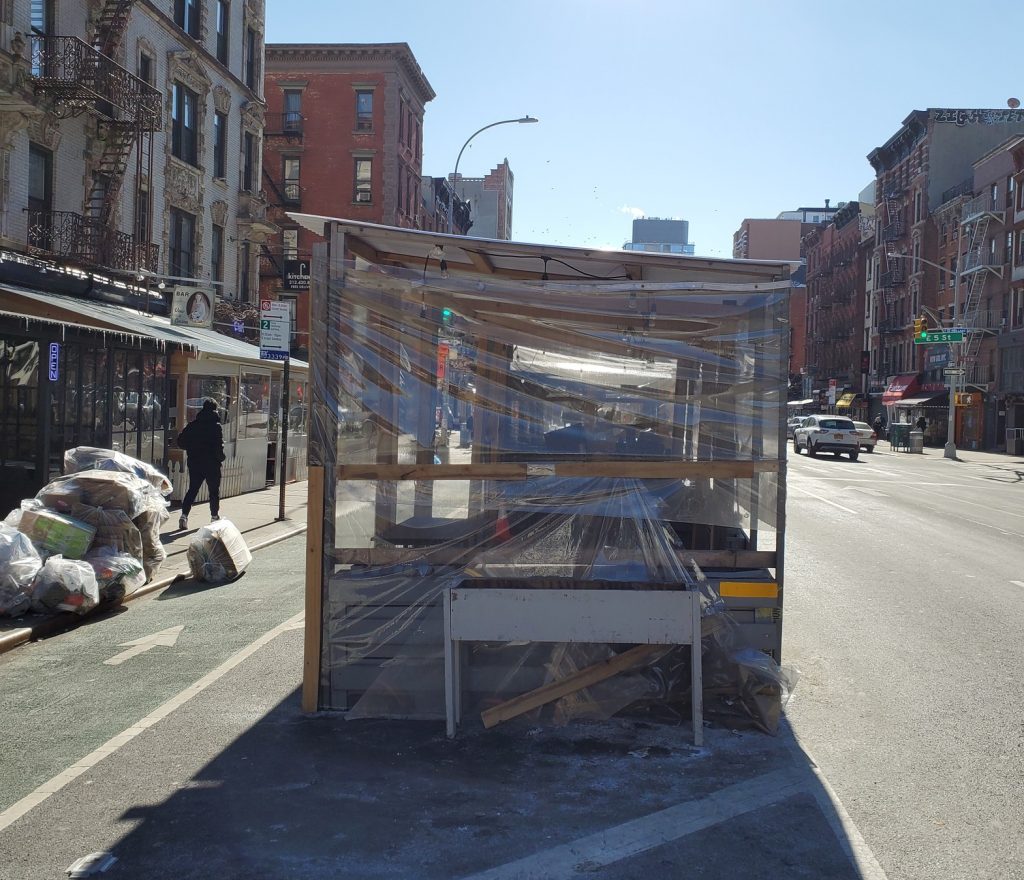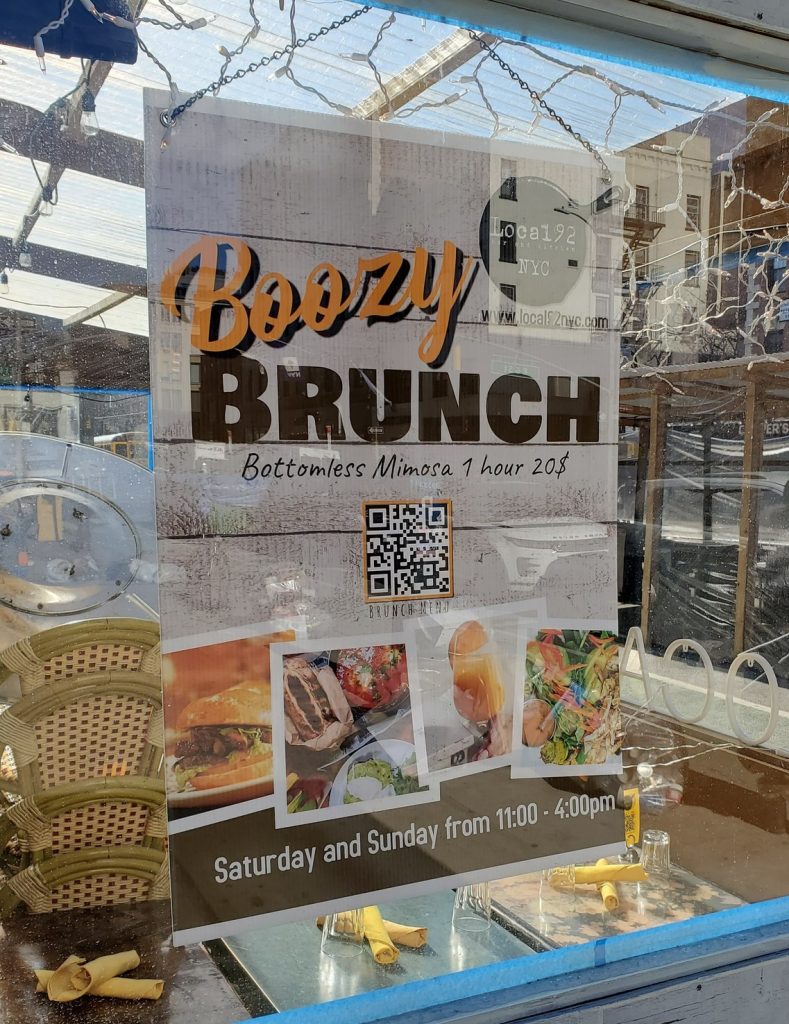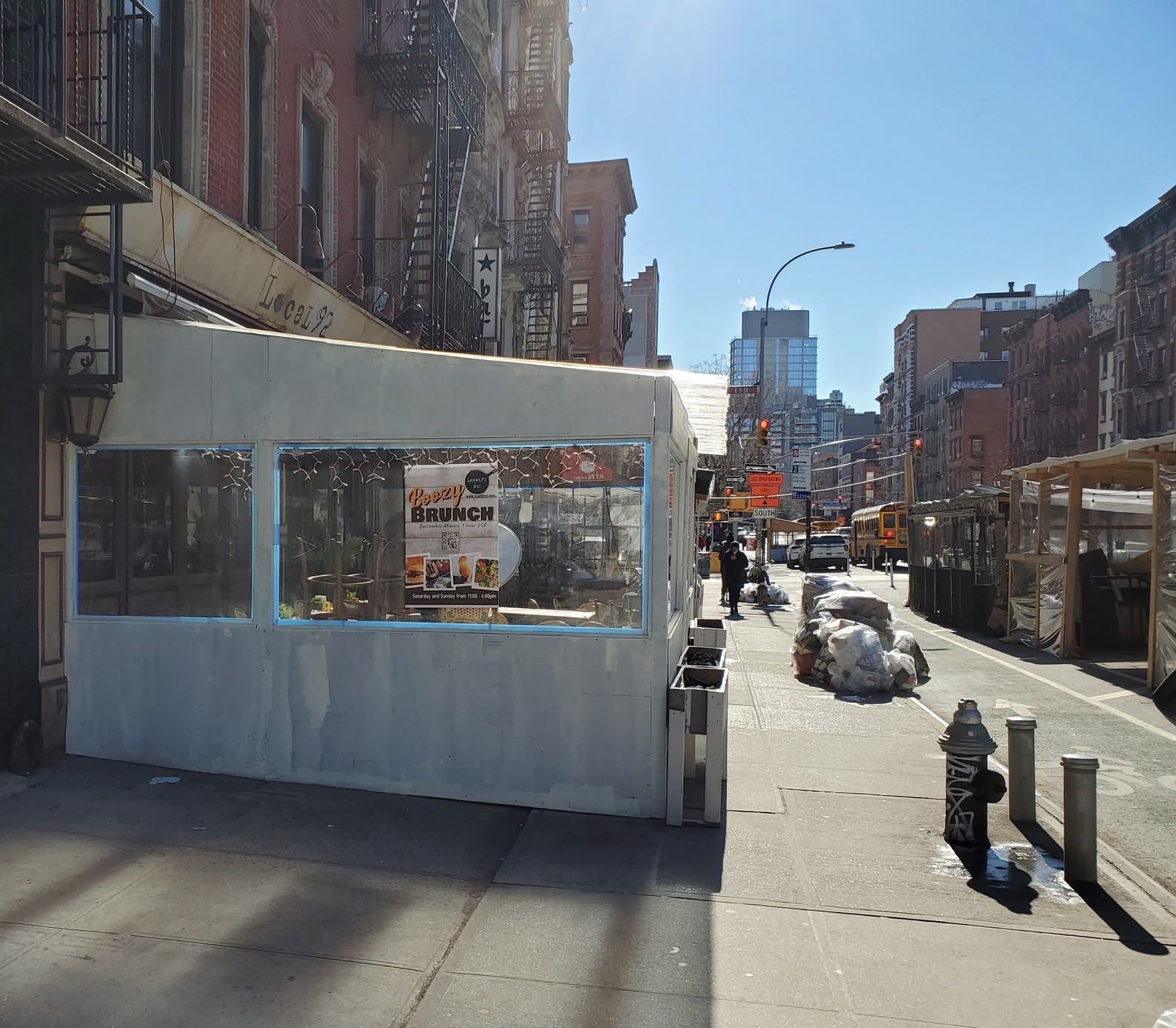BY LINCOLN ANDERSON | So what exactly is on the menu now for Open Restaurants — and, for that matter, for stressed-out Downtowners driven to distraction by the droves of “emergency” roadway dining sheds?
Basically, a lot is currently in the works and still unsettled.
The main news is that city councilmembers are currently, at long last, drafting an actual law that would make the Open Restaurants program permanent. According to councilmembers, it might take anywhere from a month to three months from now before there is a real law ready for the full City Council to vote on.
That actually does not seem like much time at all — and maybe hardly enough — considering that Open Restaurants is a program involving so many agencies and impacting the city and its residents in so many ways and on so many levels. But there reportedly is a sense of “urgency” within City Hall that this process move quickly.
Since this would be the first major piece of legislation approved under new mayor Eric Adams, Council leadership will want to pass it, not with the bare minimum of 26 votes, but with “major support” for it. So there will be an attempt to satisfy members who are leery about the program, if not outright hostile to it.

The point person on the legislation is Bronx Councilmember Marjorie Velazquez, the bill’s sponsor, who chairs the Council’s Committee on Consumer and Worker Protection. Making sure that — in addition to consumers and workers — Velazquez also fully considers the concerns of residents are Erik Bottcher and Christopher Marte, the co-chairpersons of the Manhattan Delegation. The pair represent the two Council districts with the most outdoor dining sheds in the entire city. The two Downtown Manhattan politicians have stressed that Open Restaurants can’t continue to be a “one size fits all” program.
Shed stats tell the story
There are currently more than 12,000 dining sheds in the city. Out of these, about 1,300 are in Bottcher’s District 3, which stretches from Greenwich Village to Hell’s Kitchen. Marte’s District 1, which includes Lower Manhattan, the Lower East Side, Soho and Washington Square, has 1,050 sheds. Meanwhile, Carlina Rivera’s District 2, which includes the East Village and Lower East Side, has 900 sheds, apparently the third most in the city. By comparison, the Upper East Side, represented by Councilmember Julie Menin, only has 400 outdoor dining sheds.
Velazquez is said to have taken residents’ spoken testimony very seriously at the recent nine-hour hearing on Open Restaurants that she led. In addition, her staffers are now going through the copious write-in testimony that they have received and will be distilling that down to the major points for councilmembers to consider.
The other big news is that — for the moment, at least — it’s unclear if the Department of Transportation would be the city agency that oversees and implements the permanent Open Restaurants program. Residents and some councilmembers and other local politicians have charged that D.O.T., which has crafted and run the temporary outdoor dining program so far, is simply not up to the job and is stretched too thin, and that enforcement — if any at all — has been sorely lacking.

Usually, it’s the City Council that introduces bills. But sometimes the mayor or a borough president will do it. In this case, it was Mayor Eric Adams who initiated the process to codify Open Restaurants. In the request for a bill that Adams submitted to the Council, the text identified D.O.T. as the lead agency for Open Restaurants.
Red light for D.O.T.
However, the City Council is pointedly reserving the right not to have D.O.T. be the lead agency. On Thursday, the Council’s Land Use Committee voted to “modify” the bill submitted by Adams by removing D.O.T. as the lead agency. Open Restaurants haters rejoiced at this news. However, this does not necessarily mean D.O.T. is out of the picture for good. Basically, moving forward, as part of the process of creating the new law, Velazquez and fellow councilmembers will now be deciding whether D.O.T. should continue to run the program or whether the job should be handed off to another agency. So, by deleting D.O.T. from the resolution that it passed on Thursday, the Land Use Committee has wiped the slate clean in that regard, at least for now.
In short, D.O.T. is no longer “baked in” to the legislation in any aspect and so now “must prove” that it can run the program.
Bottcher, who sits on the Land Use Committee, voted “aye,” as did all its members save for Ari Kagan, who represents Bensonhurst and Coney Island. Kagan’s concerns about the sheds were similar to those of Downtown denizens, including sanitation, rats, fire safety and A.D.A. accessibility.
“The bill will be negotiated in the coming weeks,” Bottcher said, in his remarks before the committee voted. “My goal is to help find a solution that keeps what people really like about outdoor dining while doing away with some of the elements that have been really problematic about the temporary program.”
Rivera wants ‘holistic, responsible system’
Carlina Rivera, who also sits on the Land Use Committee, is a big believer in the trend of exploring new ways to use streets, including Open Restaurants. But on Thursday she showed a nuanced approach. Perhaps showing how carefully she weighed her remarks, she appeared to be reading from a prepared statement.
“I think we all know that the pandemic provided opportunities for ingenuity out of necessity…to think about how we use our outdoor space and sidewalks in new and exciting ways,” Rivera said. “Expanding space for diners to enjoy restaurants and gather safely in public is one of those opportunities.”
Yet she also noted the program’s negatives, from narrowed sidewalks and accessibilty issues to reduced space for garbage collection and noise.
Rivera said that now, in crafting the new legislation, the City Council has the chance to develop a “holistic, responsible system for restaurants to use outdoor space…including, and especially, how those changes impact neighbors, while supporting valued small businesses and community members. Over all,” she said, “this program proved vital to our beloved restaurants and it deserves the opportunity to be improved.”
For the recording of the committee meeting, click here and scroll down to “Video Archive of Past Meetings.”
Also on Thursday, the Land Use Committee approved the removal of all current sidewalk cafe regulations from the city’s Zoning Code. Essentially, this will strip away any and all geographic restrictions on where sidewalk cafes can be located in New York City. For example, more than 130 spots on residential side streets in the East Village and Lower East Side have grandfathered commercial storefronts that would now be able to legally have sidewalk cafes. Currently, all sidewalk rules are suspended by former Mayor de Blasio’s pandemic emergency order.
‘No significant impact’
In its resolution, the Land Use Committee stated that vanishing the city’s existing sidewalk cafe rules “will have no significant impact on the environment.” Local residents and community boards would beg to differ.

A Council subcommittee also approved the two text amendments on Thursday.
The full City Council next will vote on Feb. 24 on the exact same resolution that the Land Use Committee passed.
Outdoor dining design not set yet
D.O.T. recently said that the permanent Open Restaurants program is expected to be in place by next year but that outdoor sheds would not be part of it. According to D.O.T., the “yurts,” as some called them, would be replaced by open spaces in the curbside roadbed, with movable chairs and tables and umbrellas or tents. But apparently those design specs are not set in stone. The law that Velazquez is working on will reportedly be left a bit loose in some areas, which will allow whatever agency runs the program to then fine-tune the details, which is said to be pretty standard practice for the City Council. Perhaps parking — or “free car storage,” as some insist on calling it nowadays — could even come back to these spaces during the off months of a seasonal outdoor dining program. Who knows? To hear insiders tell it, everything is on the table, no pun intended, right now.
One thing that is clear is that Velazquez, the bill’s main architect, has shown a willingness to collaborate with Bottcher and Marte to try to address residents’ concerns about the program. Velazaquez has indicated this in e-mails and tweets she has sent out about the program.
Marte, who does not sit on the Land Use Committee, is hopeful for the process that’s now moving forward. In an interview with The Village Sun, he said it was the zoning text amendment for sidewalk cafe regulations that was causing the entire process of making Open Restaurants permanent to be rushed. The zoning text change has a clock, like a ULURP review, though the process was not an actual ULURP.
The plan is for the Open Restaurants law to cover not only the roadway dining spots but also to incorporate sidewalk cafes under its umbrella. So the two are linked.
‘This was a de Blasio push’
“Because of the [sidewalk zoning] text amendment, I think a lot of it was being rushed,” Marte said. “This was a de Blasio push…to do it as quickly as possible. And, thankfully, because of the concerns of the residents, we were able to push for Open Restaurants not be under D.O.T.’s management. It’s open now — the one thing we wanted was for this not to be a giveway to D.O.T.”
Marte said he, for one, is happy to see the much-maligned agency deleted from the bill — at least for now.
“I don’t have confidence that they can run it,” he said of D.O.T. and Open Restaurants. “There’s a lot of other agencies that do this kind of enforcement and inspection. D.O.T. already does a lot. They would have to hire a lot of staff.”
He has been encouraged by bill sponsor Velazquez’s willingness to work with him and Bottcher.
“I think Marjorie Velazquez is open to doing a walk-through of certain streets with us,” he noted.
Flurry of community input
Both Bottcher and Marte said there recently was intense input from community boards and other local stakeholders, especially in the 24 hours leading up to Thursday’s Council Land Use Committee meeting, that apparently helped councilmembers to better appreciate the concerns of residents.
“There’s been a lot of work in the last few days,” Marte said. “I think there’s a lot of energy for the community and local councilmembers to have a say.”
But he, too, still feels the process of drafting the permanent law is moving too quickly, though concedes it might be hard to slow things down.
“I think it should hopefully take a lot more than a couple of months,” he said, referring to the drafting of the new law. “This is the biggest transfer of land we’ve seen in recent history.”
While there is “no clock” ticking anymore now that the decades-old sidewalk cafe rules have been dumped from the city’s Zoning Code, there still is pressure within City Hall to get the permanent Open Restaurants program finalized.
“There is no clock,” Marte said, “but I think the administration and City Council want to do it relatively soon — in the next month or two or three.”
Basically, he said, since the thinking is to start permanent Open Restaurants in 2023, the idea is to have the law in place by this spring, leaving a bit of a cushion to get things ready for the launch. But how fast the bill is passed will depend on whether there is a critical mass of councilmembers onboard with it. Velazquez is reportedly already working on the bill.
“I think the biggest battle is ahead of us,” Marte reflected. “It really depends how drastically they change the bill. If they are open to the changes the community wants, it could go quickly. But if there’s a line in the sand, it could be more difficult.”
Hoping City Council kills bill
Of course, many Downtowners, worn down, sleep-deprived and thoroughly frazzled by the dining sheds over the past nearly two years, just wish Open Restaurants would go away — permanently.
Diem Boyd, the outspoken director of LES Dwellers, said, “The lobby-fueled text amendment changes should have died in both committees yesterday. The aye votes means permanent Open Restaurants lives, to be codified into law by the New York City Council.
“The only shot we the people have is if 25 other brave city councilmembers join Councilmember Ari Kagan, the lone nay vote at committee, and refuse to buckle to special interests and kill the bill next week.”
Assuming that doesn’t happen, Boyd predicted, “There will be several drafts, lots of political theater and a whole lot of lip service that won’t amount to anything more than a hill of beans for residents. Landlords and the hospitality sector just got one step closer to complete control of our streets and sidewalks in perpetuity, across all five boroughs.
“It is the opposite of democracy!” she said. “City Hall is managing and manipulating a crisis to concentrate wealth and power in the hands of landlords and the hospitality lobby by dispossessing the public of our land. Literally, accumulation by dispossession.”


Thank you so much Lincoln Anderson for the great ongoing coverage on this topic.
yes, thanks Lincoln : )
Down in the South Village, there are even more sheds going up. Every business seems to be now grabbing every inch of sidewalk for a few more tables as well. On the weekend, when the brunch brigade shows up, navigating the sidewalks near places like the Dutch, is ridiculous, between waiters running food, people waiting for tables. I’m dreading warmer weather, sadly, in my own neighborhood.
This needs to come to an end! New Yorkers want peace and quiet – and our streets back! Government for the people! Council members where is your courage? Are you going to let the restaurant industry run your agenda? Ruin our quality of life? Why are laws that have been put in place, to protect us, now being dismissed? The restaurant industry was given a (gift), during time of emergency. Now they are a greedy runaway train. Public space is sacred in our city – not to be devoured by one industry. 27,000 restaurants – imagine the landscape, noise, garbage and safety issues, once they all participate. Take this proposal off the table! It will be a disaster – at the expense of New Yorkers!
The entire program is a sham. Dining in a shed is no safer Covid-wise than eating in a restaurant. Making a badly thought-out, temporary program permanent is just plain stupid. The only authentic agenda involved is to further privatize the public sidewalks and streets.
True!
Has anyone else noticed how little sidewalk space there is to walk lately on several avenues (e.g. 2nd and 1st Aves in the East Village)? Between the outdoor sidewalk cafe extensions and the additional garbage from the sheds there is barely 12 inches for pedestrians to walk.
Carol, join me in advocating for containerized trash! Let’s find common ground.
The concept is for trash containers to be located in the street. How will that be possible with contiguous restaurant street cafes and yurts? Will you concede a need for an area for deliveries and residential drop-off? How about widening sidewalks and reducing street width to accommodate pedestrians? What about daylighting at corners? What about at least reducing hours to 10 pm closing so residents can also have a life? Can you concede these things are important?
Yes, the containers would be in the street. You can definitely have both roadbed trash containers and roadbed dining in the street, just need to get rid of more parking. But trash containers should be prioritized over dining to the extent they are in conflict. We should also get rid of more parking to create dedicated loading zones (which should also be prioritized over dining), which could include passenger pickup and drop-off.
I’m all in favor of widening sidewalks. That’s a great idea. 10 pm closing and daylighting are also good ideas that should be part of the permanent program. Daylighting should be a citywide policy, and for cars too, not just the sheds.
Seems like we agree on a lot of this!
The bars won’t close at 10pm and half the sheds in the streets are bars, not restaurants. They stay open till around 3 am. The police say there is nothing they can do about it.
There is no parking left on my street. It’s all sheds. Who would give up their shed for containerized trash?
How about putting the freakin Citibikes only on wide sidewalks. And sheds should be a district-by-district thang, Even smaller and based on concentration and block impact. Start with a level field, start from scratch and make them each ask at community board meetings. This citiwide BS doesnt work for our Downtown ‘hoods.
They must shut at 10 PM, and 11 PM on weekends. Hell…just sidewalk cafe permits. Enuf shantytown.
Unsurprisingly, in a typical case of so many politicians’ do-as-I-say-and-not-do-as-I-do behavior, this bill’s sponsor, Marjorie Valezquez, lives on an avenue in the Bronx where not a single one of these disruptive yurts can be found for blocks and blocks and blocks, probably for miles.
But she has no problem inflicting this scourge on others.
Has she no shame?
I wonder how much she gets in campaign funding for shilling for the restaurant industry.
If our roadways and sidewalks are supposed to be shared, then old/young, cyclists/cars, able-bodied/those who are not need to be taken into consideration. Sidewalk width for pedestrians and deliveries is an essential objective element that must be taken into account, as well. The proposal as it has been put forward benefits only one sector of the business community.
Where is Carlina Rivera in all of this with the third-highest number of sheds in her district? She should be joining Erik Bottcher and Chris Marte in fighting for her constituents who face the noise, garbage, filth and fire hazards these sheds inflict rather than giving her watered-down speech that said nothing.
I have seen free ON THE SIDEWALK parking of TRUCKS on narrow West Village streets leaving no room for residents with strollers or walkers to navigate. Restaurants do not magically receive their many deliveries of liquor, beer, food, ice and linens. However there is no attention paid to where to put trucks to unload. Every day mega-size trucks are on my sidewalk in front of my doorway. They use bike lanes and No Stopping Anytime street zones because no thought has been given about this. Street space has to be practical so that sidewalks aren’t blocked by oversized trucks.
I am still amazed that we haven’t heard from automobile owners and the AAA about the loss of vehicle parking spaces. And from the Fire Department, which cannot get as close to buildings, which translates into possibly ladders not being able to reach as high as before. And why shouldn’t the City get some revenue for the restaurants’ use of public land, like the outdoor cafes had to pay for permit use of sidewalks?
The automobile owners are up in arms. You can find them in the comments here or at community board meetings. And the fire union (also car owners) has said something. This newspaper just had an interview with the union head. And the city is going to get revenue. The restaurants will pay an initial fee and a lower annual fee under the proposed permanent program (I don’t think the fee is high enough; most restaurants should pay more than is being proposed).
Explain to me how unmetered street parking is not free car storage. What other type of private property solely for my own use can I expect the city to store for free on public land?
Bicycles … sidewalk cafes (the restaurateurs’ “property”)… vendors’ tables… small benches … potted plants…
In our neighborhood, it is metered parking that has been lost. Street cleaning was every day and any cars were ticketed. Now, the street cleaner doesn’t come nor do the meter maids, so the few spots that are left have become free car storage. The patrons of the restaurants double- park on the side streets while they eat. Some just park in the crosswalk for hours, leave their car windows open and play loud music until 4 a.m. My bed shakes. There is no parking enforcement and our street is filthy and hasn’t been cleaned in almost 2 years. Many of the sheds aren’t being used for dining in the winter and are used for restaurant and garbage storage. We had some beautiful large potted plants in the street. They were taken away for outdoor dining. In the meantime, the noise is so bad, many places are open until 4 a.m. every day, I get no sleep, have developed health issues, can’t hold down a job. I can’t move without a job, so I’m stuck in this nightmare. If they could shut the outdoor part down at midnight and enforce parking, that would help a lot.
Thanks for the thorough coverage. This is the first good news I’ve read about the crap shacks.
Starting with a conclusion: There’s no ‘one size fits all’ resolution, but if that’s what’s sought, get rid of the crap shacks.
For those willing to consider a more nuanced approach, top of the list: street and sidewalk dimensions; second on the list is neighborhood sentiment. For example, Manhattan’s new Borough President Mark Levine, who previously represented Washington Heights in the City Council, has noted the popularity of outdoor dining in his district. I have no reason to doubt this, and that neighborhood’s wide avenues and sidewalks provide the needed real estate. Similarly, I’ve heard favorable comments about outdoor dining from neighborhoods in other boroughs.
Street and sidewalk dimensions are objective. Neighborhood sentiment is entirely subjective. Establish objective standards for where outdoor dining can be considered. Rely on neighborhood sentiment for where it’s actually permitted.
Community Boards are utterly toothless. Acknowledging that all board members are appointed by local councilmembers and the borough president — none are elected — and that the only essential requirement is that board members be politically docile (if not supine), I’ll cautiously suggest: Community boards should be actively engaged in deciding the suitability of each outdoor dining location.